Configure jobs
Jobs are pre-determined sets of steps, made up of tasks and deadlines. Senta comes pre-loaded with a number of jobs designed to help with the types of work you might encounter in your practice.
All Job templates are found in Settings > Jobs.
To add a new job template to Senta, go to Settings > Jobs > Add job.
To edit an existing job template, simply click on the job template title.
-
-
General tab
-
Timing tab
-
Depends upon tab
-
Filters tab
-
Advanced tab
-
Custom job status
-
Task completion date
-
-
Change the order of tasks
-
Remove tasks
-
Duplicate tasks
-
Client-specific jobs
-
-
Preview tab
Save or cancel your changes
When creating a job template, remember to select Save at regular intervals to ensure that your changes are saved. If you have any outstanding jobs (Ready, Overdue or Pending status ), these changes will be updated in those Jobs.
If you need to cancel any changes you have made since accessing the job template, simply select Cancel.

Delete a job template
To delete a job template, select Delete job. A warning will appear asking you to confirm. If you are sure to wish to delete, enter "delete job" into the text box and select Yes, delete it.

Please note: if a job template is deleted accidentally, please email support@senta.co with the name of the deleted job template and they will be able to reinstate this.
Duplicate a job template
Duplicating a job template will create a copy for you to save with a new name. This is helpful if you are making changes to existing templates but may like to refer back to them in the future. Select Duplicate at the top of the job template.
General tab
Enter the Job name and Job description. The job description will be added as a tooltip that users can hover over when selecting the job elsewhere in Senta.
Choose a colour for your job . This colour will show next to the job template in Settings > Jobs and next to your live jobs in the Work tab/Jobs list.
Dates tab
-
Enter a Job date description. The job date is set either in the Service or it is set when kicking off an ad hoc job . However, you can provide a description in the job template that will display in the Summary in the live job and also as a helpful reminder in the Service template.
-
Set a Job date format if you would like to override the default format for the job date in any job list, for example, if you format the date to be MMM YYYY, it will be forced to display as "Apr 2022" rather than "10 April 2022". For more formatting options, see our placeholders guide.
-
If you would like to include Key dates in your job , select Add date. For more information on Key dates, see our guide.
-
Once you have added Key dates, you will have the option to choose if one of those Key dates is used for reports in Senta. This dictates which month a job displays in the jobs summary. For example, the job date might be in February, but the filing deadline is in April. If you want the job to count as a job for April rather than February, you could set the date for reports to be the filing date, rather than the job date.
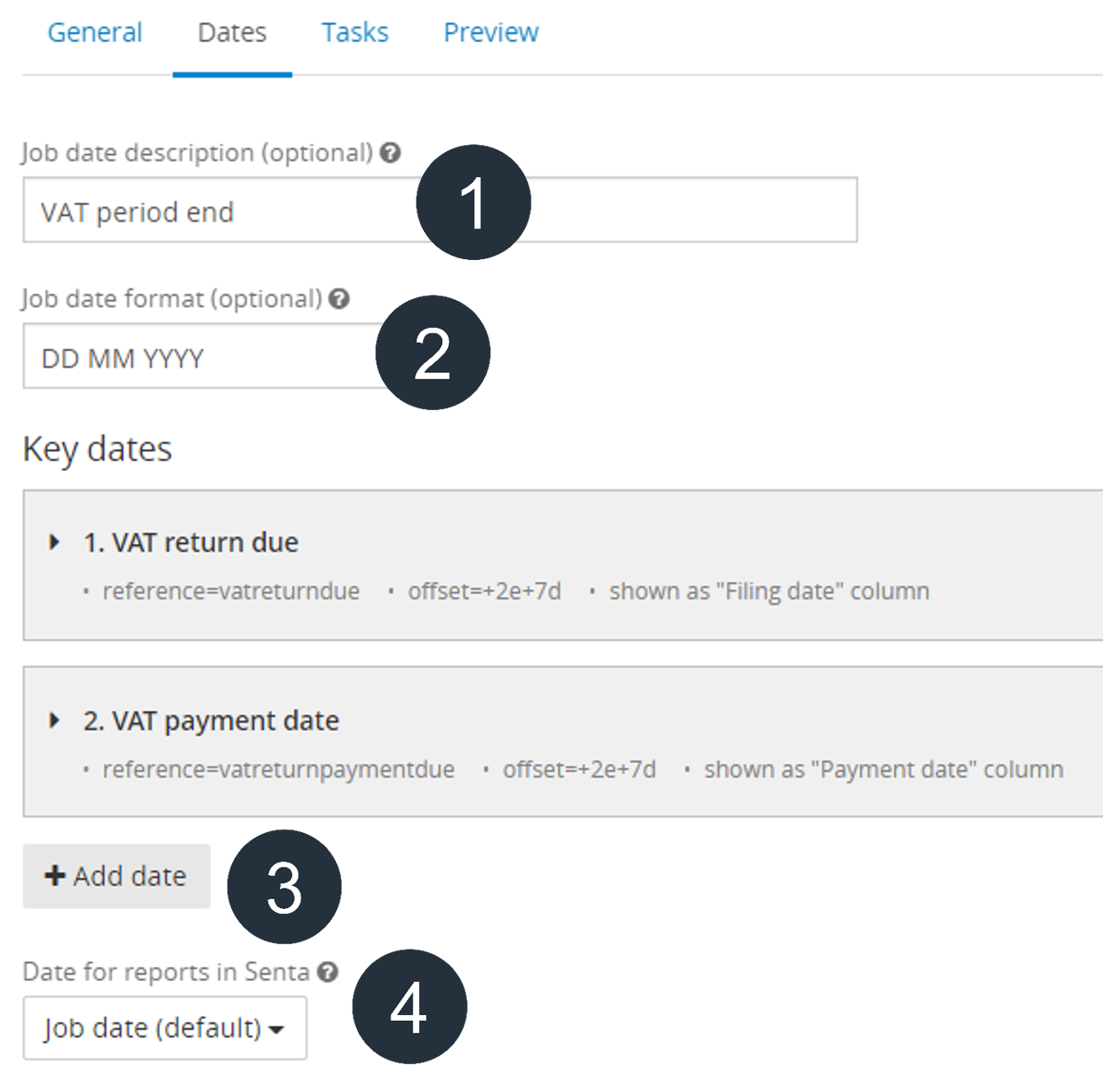
Tasks tab
Add tasks
General tab
-
Choose the Type of task from the list. There are various task types to choose from, each functioning in a different way. Find out more about task types in our guide.
-
Select who to assign the task to. Dependent on the type of task selected, you can choose between a practice user (specific user or specialist role ), a client, Senta, a Team or Unassigned.
-
Specific user - if the task is specifically assigned to Joe, this will show in Joe's task list.
-
Specialist role - if the task is assigned to the Account manager role, this will assign to the user set up as the Account manager for the specific client.
-
Client - this task will show in the Client portal (see the Task types guide to find out which Tasks can be assigned to a client).
-
Senta - assigning a task to Senta ensures that the task will complete automatically when the start date is reached (see the task types guide to find out which tasks can be assigned to Senta).
-
Team - when assigning a task to a Team, any users from within that Team can "grab" the task , reassigning this to them to find out which tasks can be assigned to Teams).
-
Unassigned - this can be useful if you have tasks in your job that are assigned to different people after the live job has been created.
-
-
Update the title of the task to appear in users' task lists. (Placeholders can be included here).
-
Enter a description if you wish to provide further information for your users when completing the task in the live job. (Placeholders can be included here).
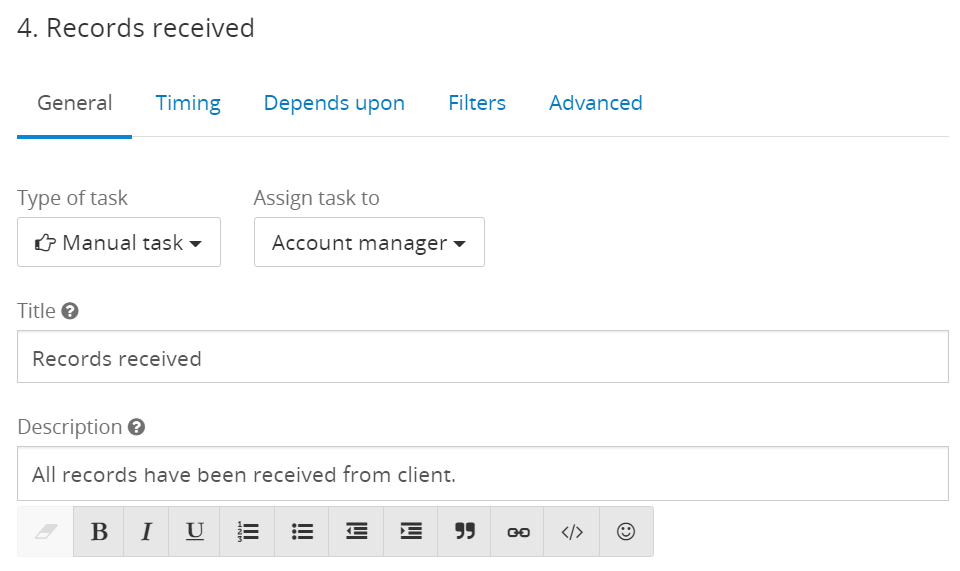
Timing tab
Tasks can be completed as and when, however you can add timings to your tasks if you like. This lets Senta know how soon a task can be started, and when it has to be finished.
Optional Start date and Due date offsets are used to tell Senta when to schedule tasks (find out more about how to use Date offsets in our guide). When a job is kicked off, Senta gives it a job date to use. Every task in the job starts relative to the job date.
If you leave the Start date offset fields blank for all of the tasks in your job template, the tasks will start on the job date. However, if we enter the date offset +2d, the Task will start 2 days after the job date.
If you leave the Due date offset field blank for a task, this task will have no due date and cannot go Overdue. However, if you include a Due date offset, the task will become Overdue the day after the due date.
Each start and due date can be added to the Task calendar (found on the Dashboard and via the Work menu) by selecting Show [start/due] date of calendar?
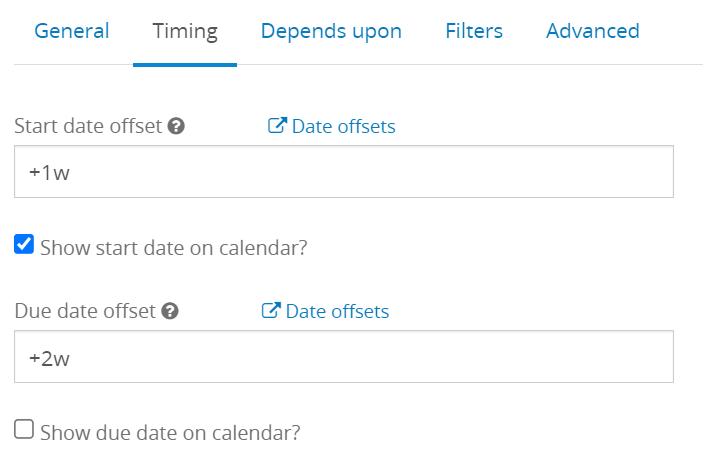
Depends upon tab
You can set up relationships, called Dependencies, between tasks, so that a particular task won't start until another has been completed. That particular task will have a Blocked status until it's dependent task has completed.

It is usually a good idea to use a dependency. Sometimes, tasks naturally have a dependency. Consider these:
-
Get some information from client
-
Do something with that information
-
Notify the client of the result
These tasks seem to have a natural sequence. There's no point in trying to do something with the information until you have actually received the information! Likewise, you can't notify the client of the result until you've done the "something" in this case. Including dependencies prevents a user's task list from becoming cluttered with task they can't complete yet.
Sometimes, however, there isn't this obvious completion order. Client onboarding jobs, for example, may have lots of tasks that need to be completed... but in any order:
-
Send welcome email
-
Send terms of business
-
Capture certain client information
-
Set up invoicing etc.
Here, the order in which these tasks are completed is less important. It is up to you to decide whether you wish to have all tasks start at the same time, or stagger the work by including depdenencies.
To add a dependency to a task, select Add dependency. This will give you a list of all previous tasks in the job template.
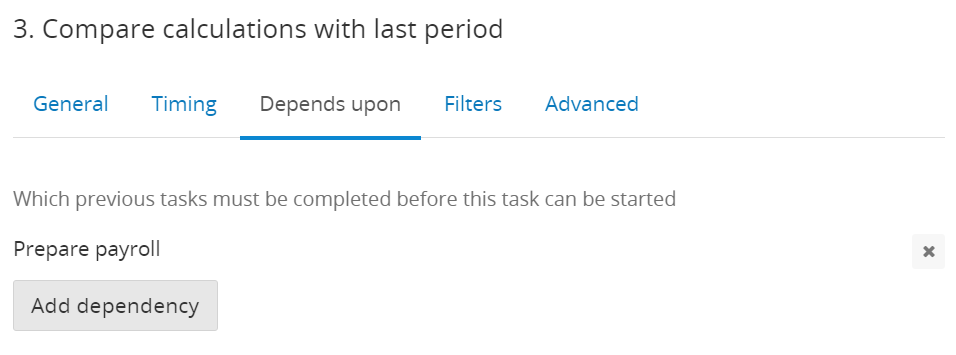
You can choose multiple dependencies for a task; this simply means that all of those dependent tasks need to be completed to allow that task to start.
To remove a dependency, select the cross icon.
If you remove a task from the job template and this was included as a dependency on another task, this dependency will remain as a Legacy dependency and must be removed to prevent the live job from not functioning correctly.
Filters tab
Ordinarily, every task in the job will be available for each client who ends up using the job. However, you can add criteria to alter which clients the tasks are applicable to. These criteria are called Filters.
You might want to use filters to fill in different forms for different types of clients, for example, "Company details form" could be applicable to Limited companies, and "Partnership details form" could be applicable to just Partnership clients.
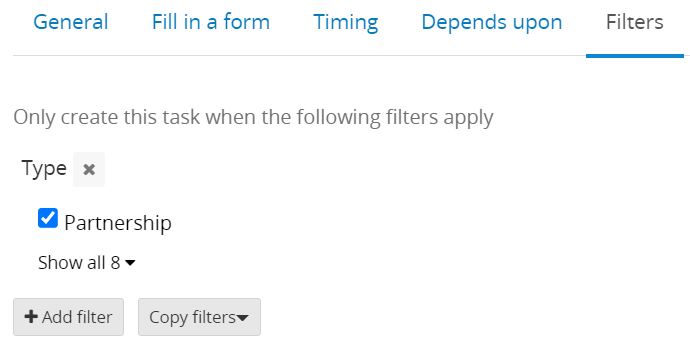
To add a filter, select Add filter and choose the field you wish to filter by from the field picker. To learn more about using Filters in Senta, see our guide.
If you are using the same filters across multiple tasks, use the Copy filters button to choose which filters to bring through from another task.
Select the cross to remove a filter.
Advanced tab
Custom job status
Under the Advanced tab, you have the option to choose an additional status for the job when that particular task is the next task in the job .
This status will show in addition to the Ready/Pending/Overdue status on any jobs list.

You can choose the status from the list to show in Job reports:
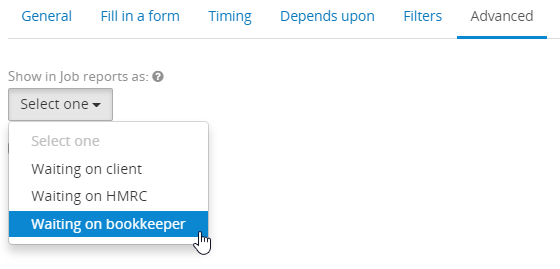
These custom statuses are pulled from a Lookup and can be edited in Settings > Lookups > Task status.
Task completion date
The completion date of a task can be stored in a field reference by selecting Store task completion date.
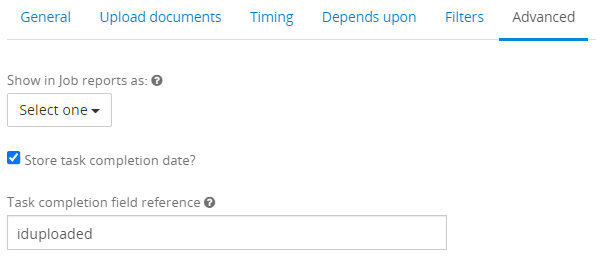
When the task completes in the live job, that date will be stored in a field reference which enables you to use this within other areas of the job, such as, placeholders, task start/due dates and Set a field value task.
See our Task completion dates guide for examples on how to use this.
Change the order of tasks
Tasks can be re-ordered in the job template. To do this, click on the task, move it to where you need it to be and let go.
Remove tasks
To remove individual tasks from the job template, click the bin on the right-hand side of the task.
To remove multiple tasks at once, select the tasks using the tick boxes and select Delete [...] tasks.
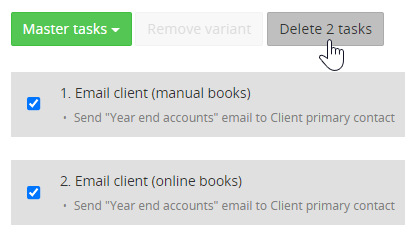
Duplicate tasks
Duplicate a task by selecting the paper icon on the right-hand side of the task in the job template.

Client-specific job
It is possible to set up slightly different versions of the job template which can be assigned to specific clients. These are called Variants.
This feature is helpful if you do things in specific ways for a small number of clients. However, we would always recommend using filters (where possible) to create flexible job templates rather than using client variants. One job template with filters is easier to manage than lots of client variant templates!
For example, filters would be a better solution:
-
If you have a group of clients who require additional tasks, such as clients requiring letters rather than emails.
-
If you group your clients by different service levels such as "Gold clients" and "Silver clients"
For both examples, this information can be stored within a form fields and used as filters to specify who these tasks are applicable to.
-
To set up a client variant on a job template go to Tasks tab > Master tasks > Add variant...
-
Select which client this variant will apply to from the list and click OK.
You can now make changes to the variant job template in the same way as making changes to the master job template.
Please note: the Autochase feature cannot be used within client variants.
Any client variants can be accessed from the top of the Tasks tab in the job template:
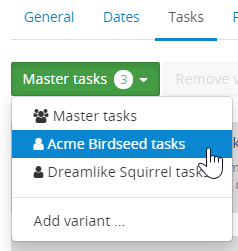
To remove a variant, click on the client from the list and select Remove variant.

Preview tab
The Preview tab allows you to see how your job template make look when it is kicked off for a client; this includes the summary of dates and the tasks.
Please note: Senta calculates the key dates and task start/due dates based on a job date of today's date, rather than the job date you will be using for your clients. For a more accurate preview of your live job , we recommend kicking this off for a test client instead.